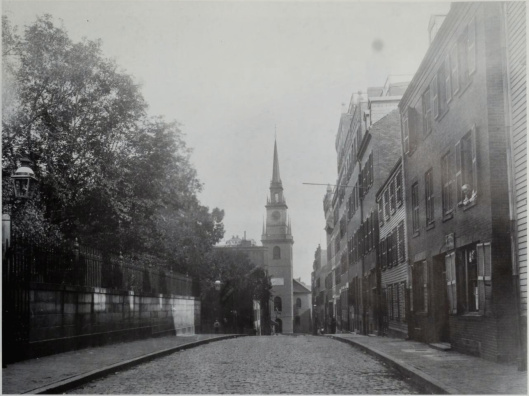In early 1923 Lovecraft investigated the old North End of Boston and climbed up to the Copp’s Hill Burying Ground, est. 1659—1825…
At present this part of the town is an Italian quarter of the most squalid sort … Thence I proceeded up the steps to that fascinating necropolis the Copp’s Hill Burying Ground. This latter spot hath for me a singular fascination … Here are interr’d some of the most illustrious Colonial dead of the Province, including the Mathers, who are interesting to me from my possession of Cotton Mather’s “Magnalia Christi Americana”. But the chief charm of the scene is in the entire broad effect; the bleak hilltop with its horizon of leaden sky, harbour masts, and Colonial roofs. Over the sod was a thin coat of snow, thro’ which the slabs peer’d grimly whilst black leafless trees claw’d at a sinister lowering sky. … As I beheld the black slate slabs rising ghoulishly above the snow, & cast my glance about at the adjacent chimney-pots, it was difficult to realise that full two centuries have pass’d since the heyday of my particular aera. … In fancy I could conjure up the Boston of the late 17th century with its narrow, hilly, curving streets and quaint wooden and brick houses.
The above is a blend of two letters mentioning the same 1923 visit, one to Galpin and one to Kleiner. Lovecraft saw this old area just in time, as on a later visit in summer 1927 he was disappointed to find that large areas of the old town had been torn down and levelled.
A few years later Lovecraft would have Pickman paint a ghoulish scene here, in “Pickman’s Model”…
Gad, how that man could paint! There was a study called “Subway Accident”, in which a flock of the vile things were clambering up from some unknown catacomb through a crack in the floor of the Boylston Street subway and attacking a crowd of people on the platform. Another shewed a dance on Copp’s Hill among the tombs with the background of today. Then there were any number of cellar views, with monsters creeping in through holes and rifts in the masonry and grinning as they squatted behind barrels or furnaces and waited for their first victim to descend the stairs.
Above we see the side of the Copp’s Hill Burying Ground on the left of the pictures, with the street much as Lovecraft would have encountered it, perhaps photographed in the late 1910s and early 1920s. Even on a winter’s day Lovecraft encountered a small crowd of such urchins outside the Burying Ground, perhaps alerted by others who had seen him climbing through the squalid Italian quarter and up the hill — their juvenile trade was to spout some memorised historical doggerel to many visiting antiquarians and historians, and then demand coins for their ‘services’…
a horde of ragged little ciceroni who surrounded me & blocked my feet whilst spouting history in lifeless, mechanical voices. It was worth a handful of farthings to be rid of these small highwaymen, whose desire to instruct the traveller is not unmixt with a craving after sweetmeats.
It sounds like some of them may have been satisfied with candy from a bag Lovecraft had brought with him. He also always carried a small bag of cat-attracting catnip on such trips.







Pingback: Return to Copps Hill | Tentaclii